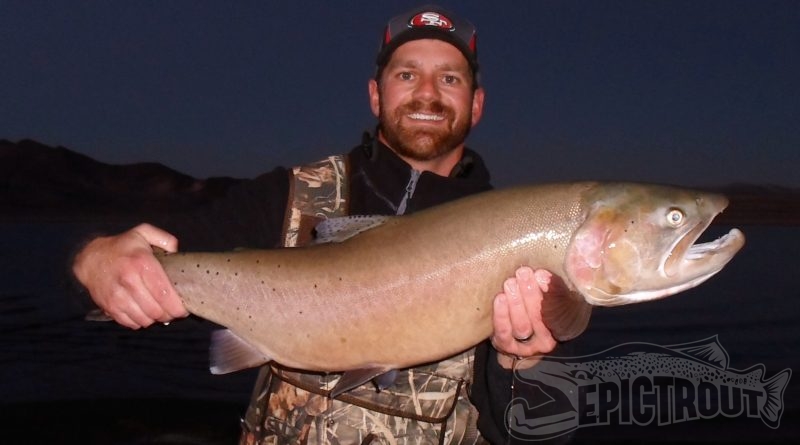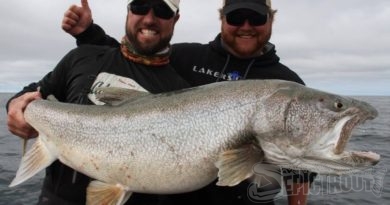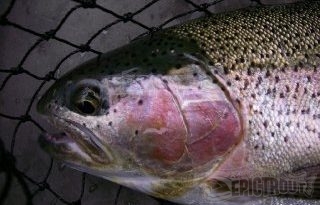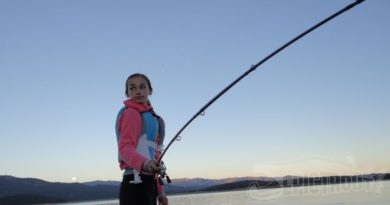Bank Fishing a Massive Desert Lake; Cold Season Tactics
A few months ago I wrote part one of the two part Pyramid Lake “how to” articles that I promised. I bet you all have been waiting like kids on Christmas morning for part two. Part one involved early season boat based tactics. Part two will center on post Christmas bank and ladder fishing.
Somewhere around Christmas time, the fishing will get slow for both bankers and boaters. The slow fishing can usually be attributed to the coldest water temps of the year. The fish just become super lethargic and feeding is minimal. However, it is also around Christmas time that the lake’s big cutts historically begin cruising the shallows in preparation for their spring spawn. Often times the biggest fish of the year are caught in January and February as they seem to be the first ones with love on their minds. That doesn’t mean that you can expect even remotely good fishing. In fact, if you are on a ladder and you catch five fish a day in January, I’d say that’s a pretty decent day. Because the fish are in the shallows, the bank based angler stands a better shot at catching a trophy cutthroat than a boater.
There’s a possibility that you may be able to completely discard the whole former paragraph I just wrote. There’s change in the wind at Pyramid Lake, and the history books are being rewritten as we speak. With the successful reintroduction of the lake’s true race of native cutthroat, we are rethinking how we approach this fishery. The Pilot Peak Cutthroat undoubtedly appears to be the true native inhabitants of the lake. They are not only growing to humongous sizes and ravaging the lake like a horde of conquering Vikings, but they also don’t necessarily follow the same playbook as the former Summit Lake stock. The Summit Lake fish usually began migrating towards the Sutcliffe fish hatchery and the Nets Beach sometime in February. However, we haven’t actually seen a mature age class of what I’m calling, “true native cutts,” come to age and try to spawn. The preliminary results are starting to come in, and we are seeing what appear to be pre spawn fish as early as October. I’ve been hearing stories of guys catching big female cutthroat with “Pautzke sized eggs” inside them. I haven’t heard of anybody catching an amorous male yet complete with male love juice in the fall, but I’m sure the day is coming. The historical records indicate that these fish probably entered the Truckee River as soon as the first big fall, winter, or spring storm opened the river’s mouth and allowed access up the fluvial highway. Typically the residents of pre Derby Dam western Nevada could count on the trout being in the river sometime around Thanksgiving. I’ve had a hard time finding evidence of when these fish actually spawned. Are they fall/winter spawners, or did they overwinter in a deep dark hole in the Truckee River and spawn in the spring? Now that they are completely dependent on hatchery reproduction, the river no longer plays a roll. The bigger question is if we will see sexually mature Pilot Peak stock looking to spawn on a beach in November, or if we will see them cruise the shallows in February-May like the old Summit Lake stock did. The jury is still out. Hear me now and believe me later, I contest that we will see great fishing in the spring in the next few years when the first mass of Pilot Peak fish start thinking about spawning. A few of them have already turned up. They are easily discerned from the Summit Lake fish if they have a missing adipose fin and a tag in their back. Not all of them will have the tag in their back, and some Summit Lake fish have missing adipose fins. Not to mention the Pilot Peak fish seem to mature at the size of 8-20lbs and possibly much larger.
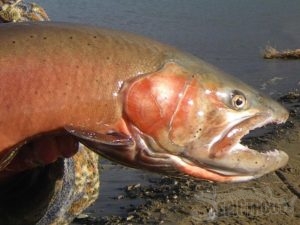
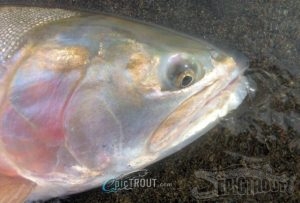
The Summit Lake fish are still in the lake, and the tribe plans to continue stocking them, so they will remain part of the fishery to some degree. You can bet on catching Summit Lakers around the hatchery and in particular the Nets Beaches during March and April. As soon as the water begins flowing from the hatchery to the lake, there will be literally thousands of Summit Lake Cutts heading to the raceway. They may not be as big as the Pilot Peak fish, but they are beautiful. It’s hard to beat a 10lb fire truck red Summit Lake buck.
The Fishery has changed, but has the Tactics?
No. They still love to eat a wooly bugger, jig, or even a little bug under a bobber. If anything has changed, I’d say it’s the fact that these Pilot Peak fish are meat-o-sauruses, and they seem to be more vulnerable to the spoon tossing crowds off the deep beaches. It makes sense that a highly piscovorous fish would be apt to want a large meal. These things are extremely efficient predators of Tui chub, and a herky- jerky retrieve on a Kastmaster, Little Cleo, Pixee or similar spoon is going to draw strikes. The biggest Pilot Peak fish have mostly been falling to spoons off the deep beaches like Wino, Blockhouse, and Sand Hole. Chances are if you see me out there on my ladder, I will be fishing a marabou jig most of the time. Day in and day out, a ¼ ounce black marabou jig is going to catch more big fish than any other tactic. It’s just such a dynamic way to fish. You can gently hop the jig along the bottom and make lethargic fish strike, or you can violently hop it and draw a reaction strike. Once the fish is hooked, you stand the best chance of landing the 30lber that we all know is coming in the near future on a jig and spinning rod combo. For my money, I think a 2500 sized spinning real loaded with 10lb/2lb diameter braid and a 2/0 sized jig offers the best chance of success. For one thing, the hook isn’t going to bend. Secondly, the 10lb braid gives you plenty of line capacity if a big goes on a sustained run. These Pilot Peak fish are not like the old Summit stock. The old Summit Lake fish liked to headshake just below the surface and make short runs when they were hooked. These Pilot fish like to make strong sustained runs. There isn’t much of a comparison between the two races in how they react once hooked.
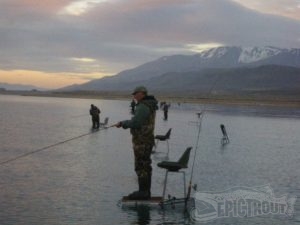
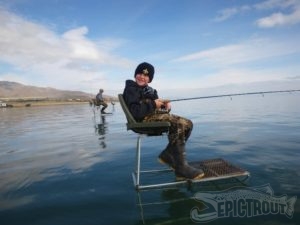
Fly fishing tackle remains unchanged as well. The basic setup is still a 9ft. 8wt fly rod with 20lb Amnesia running line and a properly matched section of T-11 shooting head. This combo allows for the longest possible cast with the least amount of effort, and the fly gets down and stays down where it’s supposed to be; the bottom. As far as fly selection goes, you can catch fish every single day of the year with two flies in your arsenal. Make sure you have a couple white and black size 4 wooly buggers, and you’re good to go. If you feel like being a real fancy pants, you can throw in some beetle patterns and some other colors of buggers.
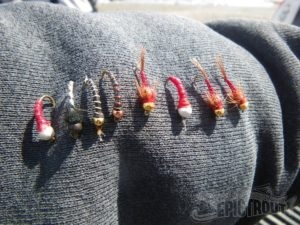
There are also the guys that like to throw a floating line and bobber setup with a couple of nymphs. This is about as simple of a setup as it gets. In fact, there’s not much difference between hanging a midge larvae under an indicator and a nightcrawler under a red and white bobber. It’s the same basic principle. Figure out what depth you want your offering, place the bobber at the appropriate distance from the bait, cast, wait, repeat until the bobber submerges and a fish is hooked. It cracks me up to see the guy with the 600$ Sage Rod in the 700$ Simms Waders that is basically fishing for bluegill with a nightcrawler. In contrast, I’ve seen a 400lb master angler sit in his lawn chair, burn a butt, and drink a beer on the beach at Blockhouse while utilizing the same technique as Mr. Nympher. I don’t mean to besmirch the technique, but it really is that simple. In the old days I used to deny that it catches big fish, and that was untrue. It definitely is a worthy technique, but keep in mind this article is editorial in nature, and I say here and forever that it is the least effective tactic to target trophy cutthroat. Let’s suppose Mr. Nympher hooks his monster cutthroat on that size 12 Copper John and a 5x tippet. What do you suppose his chances are of landing that fish vs. the guy throwing the 2/0 jig on a 15lb leader? Enough said.
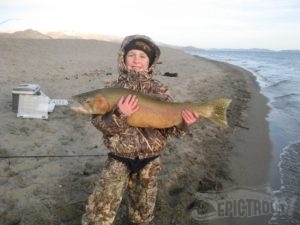

Choose Your Days Wisely
Although every day is a good day to go fishing, some days definitely offer a better shot at a big fish than others. Cloudy, windy, and warm days offer the tri-fecta of perfect conditions. I’d settle for any one of those conditions, but if you can get all three, you are cooking with gasoline. The absolute best scenario you can hope for is as follows: just enough sustained wind to give the lake a good 1-2 foot chop. Ideally, the wind will come from your offhand side, so as not to interfere with your casting. After hooking one’s self in the ear, arm, and neck a few times, an offhand wind becomes extremely valuable. Hopefully, the wind has been blowing all night long, and a nice mud line has developed. Next, it just so happens that the wind was caused by an approaching unusually warm storm that has raised the air temp to almost 60 degrees. Lastly, the sky is overcast and low light conditions prevail throughout the day. If you have conditions like that, you might as well plan on catching at least a big fish, and possibly several.


